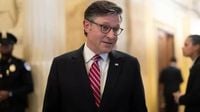In a week marked by political theater and escalating tensions, President Donald Trump has turned to artificial intelligence-generated videos to troll his Democratic opponents during the ongoing government shutdown, igniting fierce debate over both the substance of his administration's policy moves and the tone of its public messaging. The president’s social media accounts have been flooded with AI-crafted deepfakes, featuring everyone from budget chief Russ Vought to House Minority Leader Hakeem Jeffries, as the White House pushes for deep cuts to federal agencies and layoffs of government workers.
On October 2, 2025, President Trump posted a particularly striking AI-generated video on Truth Social. The video depicted Russ Vought, director of the Office of Management and Budget and a key architect of the conservative policy blueprint Project 2025, as the Grim Reaper. Dressed in a dark cloak and wielding a scythe, Vought was shown parading through the Capitol, cowbell in hand, as Blue Öyster Cult’s “Don’t Fear the Reaper” blasted in the background. The video’s narration declared, “Russ Vought is the Reaper. He wields the pen, the funds and the brain. Here comes the Reaper.” According to ABC News, this imagery was meant to underscore the administration’s threats of mass layoffs and sweeping cuts to what Trump has labeled “Democratic agencies.”
Trump’s meeting with Vought earlier that day was no mere photo op. Vought, who co-authored Project 2025, has been instrumental in shaping the administration’s aggressive approach to the shutdown. Project 2025 calls for the firing of federal workers and the elimination of numerous federal agencies, and Vought has wasted no time putting these proposals into action. In the days following the meeting, he announced the withholding of federal funding for transit infrastructure projects in Democratic strongholds like Chicago, New York, and New Jersey. The Associated Press reported that these moves have already resulted in the cancellation of $8 billion in green energy projects and the stalling of $18 billion for transportation initiatives in New York City, championed by Senate Democratic Leader Chuck Schumer and House Democratic Leader Hakeem Jeffries.
But it was Trump’s use of AI-generated videos to lampoon his political rivals that truly set social media ablaze. On October 2, the president posted another AI video, this time showing himself tossing a red “Trump 2028” hat onto Jeffries’s head during a tense Oval Office meeting. The video, set to the Village People’s “Y.M.C.A.,” showed Trump pointing and laughing as the hat landed, a scene that was based on real photos from a meeting earlier in the week. According to Nexstar Media, these hats had “just randomly appeared in the middle of the meeting on the desk,” and Jeffries later told CNN, “It was the strangest thing ever. I just looked at the hat, looked at [Vice President] JD Vance, who was seated to my left, and said, ‘Don’t you got a problem with this?’ and he said, ‘No comment.’ And that was the end of it.”
Trump’s penchant for AI deepfakes didn’t stop there. Throughout the week, he posted several more videos targeting Jeffries, including one that depicted the Democratic leader with a fake mustache and wearing a sombrero—an image that Jeffries promptly labeled “racist” and “bigoted” during an interview with MSNBC. Latino advocacy groups quickly condemned the video, and the episode sparked a wider conversation about the use of racial stereotypes in political messaging.
Republican leaders, however, have largely brushed off the controversy. Vice President JD Vance told reporters on October 1, “The president’s joking, and we’re having a good time.” House Speaker Mike Johnson echoed this sentiment, stating on October 3, “Are they taking great pleasure or not? No. Is he trolling the Democrats? Yes. Because that is what President Trump does and people are having fun with this. But at the end of the day, the decisions are tough. The effects are really serious on real people, real Americans.” Johnson added that while the memes and videos may be entertaining to some, the administration was not taking pleasure in the prospect of layoffs, emphasizing, “We support federal employees who do a great job in all of these different areas, but what they’re trying to have fun with, trying to make light of, was to point out the absurdity that is the Democrats’ position.”
White House press secretary Karoline Leavitt also weighed in, defending the president’s posts as a blend of humor and seriousness. When pressed by ABC News Chief White House Correspondent Mary Bruce about whether the layoffs were an “opportunity” or an “unfortunate consequence,” Leavitt replied, “He likes to have a little fun and both can be true at the same time. We don’t like laying people off. Nobody takes joy and if you think that, that’s very sad you view the White House and our staff as wanting to put people out of work. Nobody wants to do that but sometimes in government, you have to make the tough decisions.” Still, Leavitt dodged questions about whether the federal layoffs could continue after the shutdown ends.
On the other side of the aisle, Democrats have condemned both the administration’s policy moves and its use of AI-generated videos. Jeffries, during his MSNBC interview, argued, “It’s further confirmation that Republicans are the ones who were clearly determined to shut the government down because everything that President Trump has done subsequent to Monday has been unhinged and unserious. In fact, Donald Trump is in the presidential witness protection program. No one can find him when it comes to the government shutdown issue because he knows he’s responsible for having caused it. And the behavior, the erratic behavior that we’ve seen, is further confirmation of that unfortunate fact.”
The legal implications of Trump’s threats to cut federal agencies have not gone unnoticed. Legal experts have pointed out that only Congress has the constitutional authority to declare cuts to federal agencies or remove them entirely. As of October 3, the White House had not provided further details on the legality of the president’s threats, nor had it addressed questions about how firing workers who are already not being paid would reduce government waste.
Meanwhile, the use of AI-generated videos as both a political weapon and a source of entertainment has become a hallmark of this shutdown. Not to be outdone, Senator Ted Cruz posted his own parody video showing Senate Democrats sporting sombreros and mustaches, set to a Trump-like parody of “Macarena.” The battle of the memes, it seems, is not confined to the White House.
As the shutdown drags on and the rhetoric heats up, the line between political messaging and spectacle grows ever blurrier. The administration’s embrace of AI deepfakes, coupled with its aggressive pursuit of Project 2025’s goals, has left federal workers and political observers alike wondering what the next act in this high-stakes drama will bring. For now, the only certainty is that the memes—and the controversy—are here to stay.






